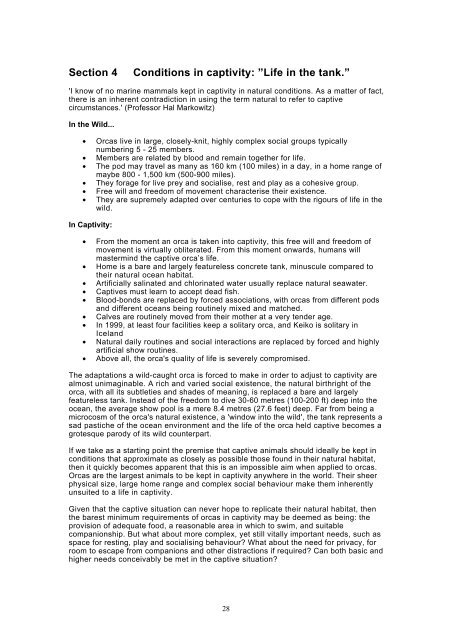Captive Orcas 'Dying to Entertain You' - Whale and Dolphin ...
Captive Orcas 'Dying to Entertain You' - Whale and Dolphin ...
Captive Orcas 'Dying to Entertain You' - Whale and Dolphin ...
You also want an ePaper? Increase the reach of your titles
YUMPU automatically turns print PDFs into web optimized ePapers that Google loves.
Section 4Conditions in captivity: ”Life in the tank.”'I know of no marine mammals kept in captivity in natural conditions. As a matter of fact,there is an inherent contradiction in using the term natural <strong>to</strong> refer <strong>to</strong> captivecircumstances.' (Professor Hal Markowitz)In the Wild...• <strong>Orcas</strong> live in large, closely-knit, highly complex social groups typicallynumbering 5 - 25 members.• Members are related by blood <strong>and</strong> remain <strong>to</strong>gether for life.• The pod may travel as many as 160 km (100 miles) in a day, in a home range ofmaybe 800 - 1,500 km (500-900 miles).• They forage for live prey <strong>and</strong> socialise, rest <strong>and</strong> play as a cohesive group.• Free will <strong>and</strong> freedom of movement characterise their existence.• They are supremely adapted over centuries <strong>to</strong> cope with the rigours of life in thewild.In Captivity:• From the moment an orca is taken in<strong>to</strong> captivity, this free will <strong>and</strong> freedom ofmovement is virtually obliterated. From this moment onwards, humans willmastermind the captive orca’s life.• Home is a bare <strong>and</strong> largely featureless concrete tank, minuscule compared <strong>to</strong>their natural ocean habitat.• Artificially salinated <strong>and</strong> chlorinated water usually replace natural seawater.• <strong>Captive</strong>s must learn <strong>to</strong> accept dead fish.• Blood-bonds are replaced by forced associations, with orcas from different pods<strong>and</strong> different oceans being routinely mixed <strong>and</strong> matched.• Calves are routinely moved from their mother at a very tender age.• In 1999, at least four facilities keep a solitary orca, <strong>and</strong> Keiko is solitary inIcel<strong>and</strong>• Natural daily routines <strong>and</strong> social interactions are replaced by forced <strong>and</strong> highlyartificial show routines.• Above all, the orca's quality of life is severely compromised.The adaptations a wild-caught orca is forced <strong>to</strong> make in order <strong>to</strong> adjust <strong>to</strong> captivity arealmost unimaginable. A rich <strong>and</strong> varied social existence, the natural birthright of theorca, with all its subtleties <strong>and</strong> shades of meaning, is replaced a bare <strong>and</strong> largelyfeatureless tank. Instead of the freedom <strong>to</strong> dive 30-60 metres (100-200 ft) deep in<strong>to</strong> theocean, the average show pool is a mere 8.4 metres (27.6 feet) deep. Far from being amicrocosm of the orca's natural existence, a 'window in<strong>to</strong> the wild', the tank represents asad pastiche of the ocean environment <strong>and</strong> the life of the orca held captive becomes agrotesque parody of its wild counterpart.If we take as a starting point the premise that captive animals should ideally be kept inconditions that approximate as closely as possible those found in their natural habitat,then it quickly becomes apparent that this is an impossible aim when applied <strong>to</strong> orcas.<strong>Orcas</strong> are the largest animals <strong>to</strong> be kept in captivity anywhere in the world. Their sheerphysical size, large home range <strong>and</strong> complex social behaviour make them inherentlyunsuited <strong>to</strong> a life in captivity.Given that the captive situation can never hope <strong>to</strong> replicate their natural habitat, thenthe barest minimum requirements of orcas in captivity may be deemed as being: theprovision of adequate food, a reasonable area in which <strong>to</strong> swim, <strong>and</strong> suitablecompanionship. But what about more complex, yet still vitally important needs, such asspace for resting, play <strong>and</strong> socialising behaviour? What about the need for privacy, forroom <strong>to</strong> escape from companions <strong>and</strong> other distractions if required? Can both basic <strong>and</strong>higher needs conceivably be met in the captive situation?28
















